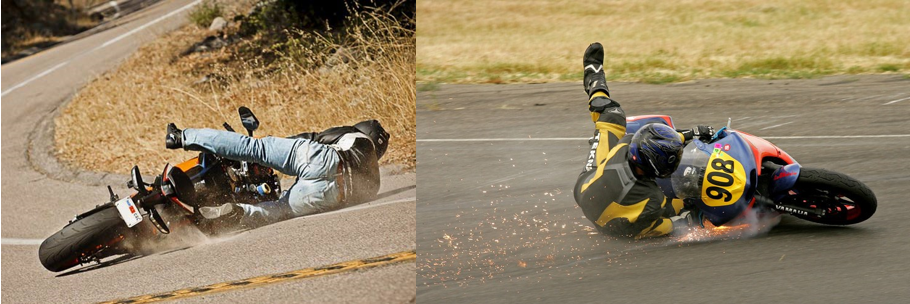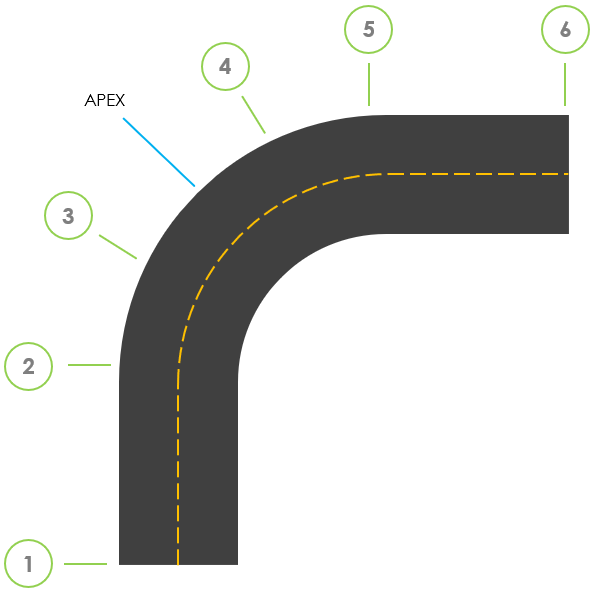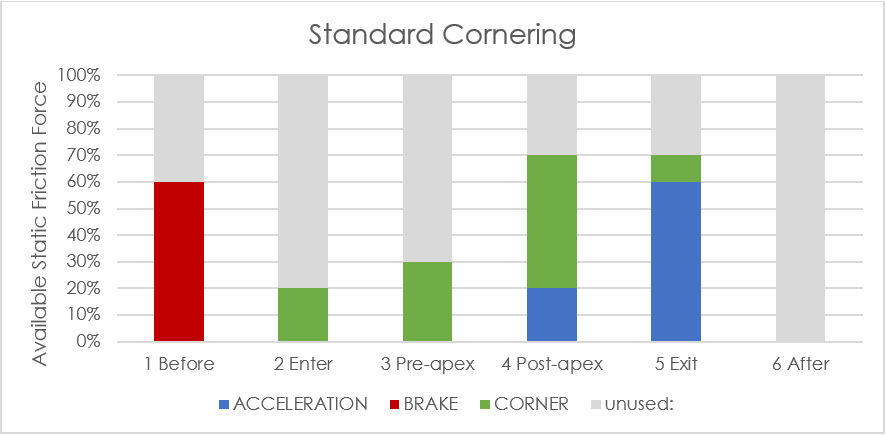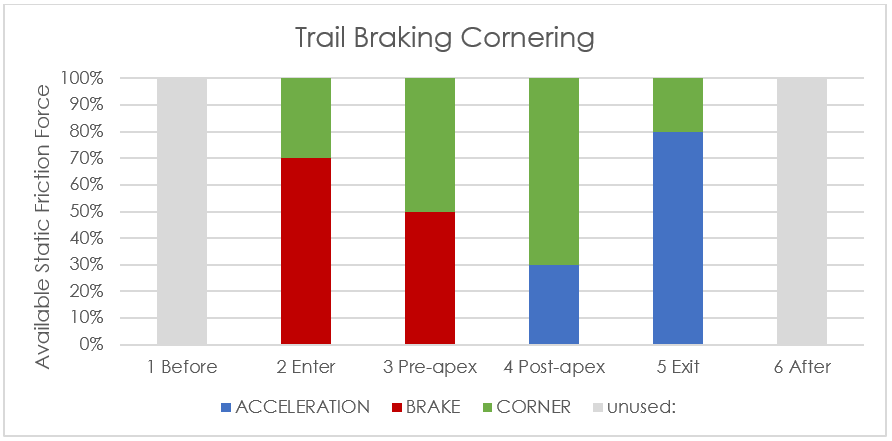The Physics of Motorcycle Trail Braking
Here at DesignThink, our team often gets into nerdy discussions about common interests: new tech, hobbies, cars, etc. For example, what’s the best mountain bike tire size? Which measurement system reigns supreme – imperial or metric? Obviously metric. Are calzones, dumplings, and egg rolls all just burritos in disguise? The jury is still out on that last one.
One area that several of us have interest in, is motorcycles. Riding them, ripping them apart, putting them back together, customizing, and everything in between. Something that has always interested me personally is the physics involved with these two-wheeled machines; things that engineers must take into consideration to ensure a bike performs as expected. For instance, the insane amount of stress induced on a chassis/chain by pulling a wheelie on a 400+ pound vehicle. However, what has peaked my interest more recently is a technique used by advanced and professional riders called trail braking, and the physics involved with this technique.
If you ride motorcycles, or have ever taken a motorcycle safety course, you will likely have been given one particular piece of advice over and over again from other riders or an instructor: never, EVER brake in a corner. This basically means that if you are going around a corner while riding and are leaning over, you should not even think about applying your brakes. This is taught by motorcycle safety courses around the country and is often advice given to beginner riders – and for good reason. Braking in a turn can be a very dangerous ordeal for a motorcyclist as it can result in a crash.
Most motorcycle crashes that occur in a corner (barring accidents involving other vehicles or objects) can be classified into one of two types: lowside and highside. A lowside crash occurs when either the front or rear wheel loses traction, causing the motorcycle to lay down horizontally sliding across the ground with the wheels leading and the tank/seat trailing. This can occur when the tires encounter loose gravel or debris on the road, but is often the result of rider error when applying excessive braking in a corner causing the tires to lose traction. It looks a little something like this.
Believe it or not, the lowside is probably the kinder crash compared to its sibling. Highsides occur when the rear wheel loses traction with the road and then suddenly regains traction. This causes the motorcycle to whip over towards the outside of a turn and violently send the rider flying through the air, much like Buzz Lightyear but with a less graceful landing. These unfortunate riders got a crash course in flight.
I’ve hopefully convinced you by now that lowsides and highsides are no bueno and for these two reasons, beginner riders are taught to never brake in a corner.
The problem with giving this instruction as absolute law is that it implies that a motorcyclist WILL crash if he or she disobeys this command. This simply isn’t true. A more accurate instruction to give riders would be “never exceed the total available static friction force limit of your bike,” however this would likely just cause confusion, and it is therefore easier and safer to tell riders that if they need to brake, do it before entering a corner, after a corner, or right the motorcycle and then apply the brakes if you find yourself in an emergency situation in a corner.
So, what does available static friction force mean? To properly understand this, you’ll need to understand how friction works. Friction is simply an object’s weight multiplied by a friction factor, µ. This friction factor is dependent on what two surfaces are touching each other. For example, set your phone on a table. Gently apply a small amount of force to the phone and it will not move. As you apply more force eventually the phone brakes free from the table and begins to slide. What you are seeing is static friction at work. The phone’s weight multiplied by the friction factor between the phone and the table give it some friction force with which to resist your push. This works the same way between a tire and pavement.
All vehicles depend on friction to prevent the tires from sliding in order to propel the vehicle forward or to slow it down. Friction is also important when going around corners so that a car or motorcycle does not just slide off the side of the road due to centrifugal force (that feeling you get that pushes you against the door of your car when making a tight right turn). However, there is a limit to how much friction force is available to any given vehicle. This limit is different for each vehicle and is not even constant for a single vehicle. Friction force can change due to road conditions, type of tire, road surface material, and many other factors. Regardless of the situation, there is always a limit, and acceleration, braking, and cornering, are the three major factors that rely heavily on friction. You could think of the available friction force as an empty glass. You can choose to fill the glass with any of three liquids (acceleration, braking, and cornering) in varying amounts up to the brim (friction force limit). If too much is poured, you exceed the capacity of the glass and the liquid spills (your wheels lose traction with the ground). The one caveat to this analogy being that, in reality, you cannot both brake and accelerate at the same time.
Let’s look at a corner and break it up into six segments: 1. before the corner, 2. the entrance to the corner, 3. before the apex of the corner, 4. after the apex, 5. exiting the corner, and 6. after the corner once a rider is fully out of the turn.
As mentioned previously, most beginner riders are taught to apply their brakes before entering a turn. The turn can then be initiated by leaning the bike over and smoothly applying throttle to accelerate the bike throughout the turn. Once completely out of the turn, you may apply as much or as little throttle as desired. If you break this down very simply it might look something like this, though take these numbers with a grain of salt as they are only being used to explain this idea and not real data. Also, keep in mind that a motorcycle moving in a straight line and at a constant speed is effectively using zero percent of its available friction force.
Here is where trail braking comes into play. While this standard cornering technique is certainly less risky, it is also inefficient. See those grey bars? That is unused available friction force, and for a professional rider, that means you are not moving as fast as you could be. The idea behind trail braking is to use up as much of the total available friction force throughout a corner as possible, without ever exceeding 100% (remember, you don’t want to over fill the glass, lest risk becoming airborne). The same graph of a professional rider utilizing proper trail braking technique would look more like this.
Notice that the big difference here is in the first three stages of the corner. When using this technique, a rider waits until just before they enter the corner to apply the brakes. As they move closer to the apex of the turn and their lean angle increases (increasing the demand for cornering friction force), they gradually use less braking, always attempting to keep the glass as close to full as possible. Applying the brakes later means a rider can approach a turn with higher speed and utilizing as much of the available friction force as possible ultimately means a rider will get around a corner faster. In reality, it is nearly impossible to use exactly 100% of the available friction force as a human rider has no gauge to see how close they are to the limit. Professional riders are, however, trained to get as close to this limit as possible, which is why it is not uncommon to see them lowside during a race. Additionally, many modern motorcycles are equipped with advanced electronics that calculate acceleration, roll, pitch and yaw angles hundreds of times per second with the computer intervening when necessary to allow motorcyclists to ride as close to this limit as possible without fear.
While I would not recommend trail braking to a beginner, it is a fun technique to practice as you become more accustomed with riding and your motorcycle. And while professional riders are trying to fill their glass up to the brim, that doesn’t mean you have to. Average riders can safely practice this technique as long as they proceed with caution and make sure to leave themselves a little extra wiggle room. Just remember, Buzz Lightyear had wings, and if you exceed your total available friction force limit, I guarantee you won’t be falling with style. Happy riding!






